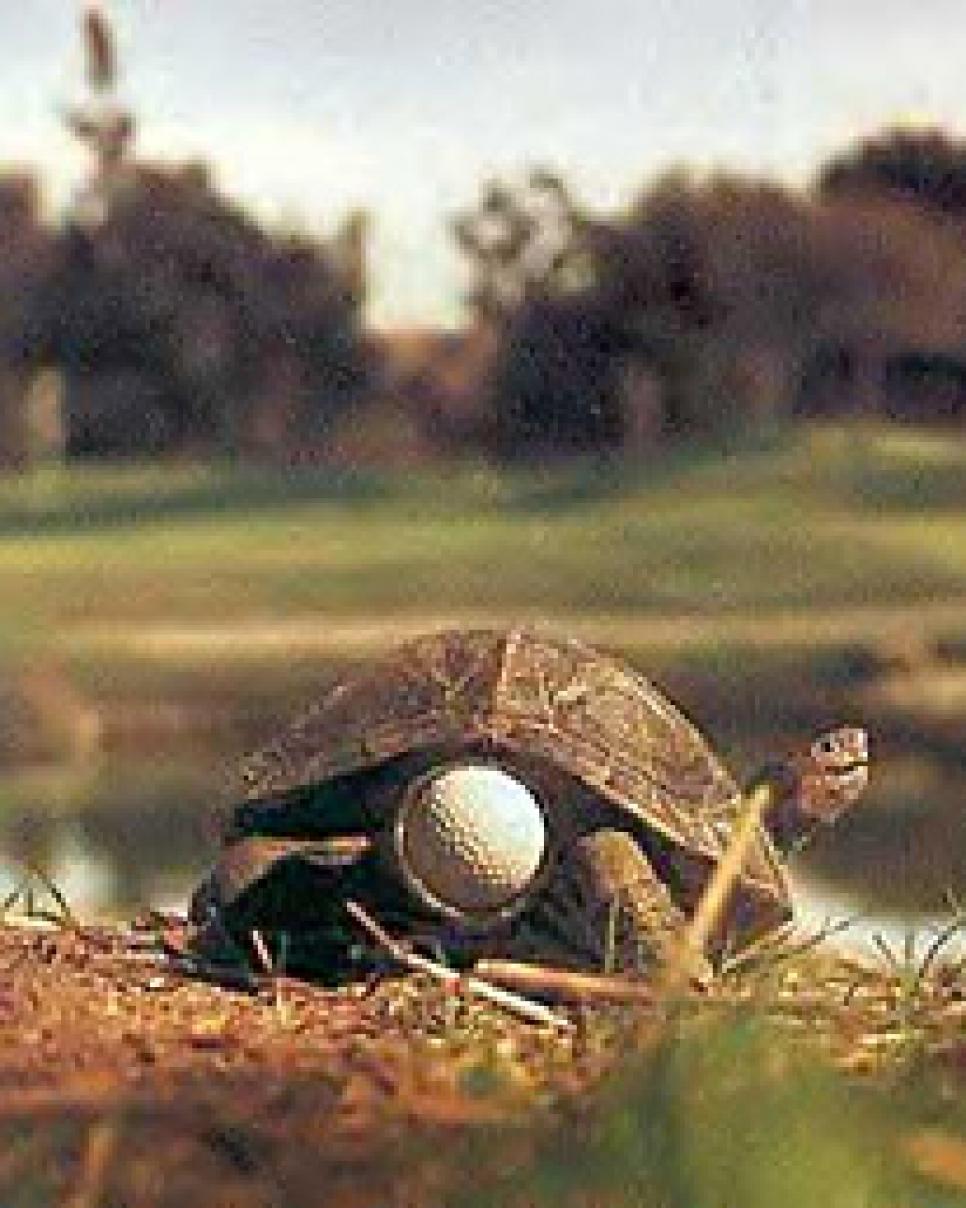News
Confronting The PGA Tour's Slow-Play

Maybe the turtle has a message for the PGA Tour.
It's really no secret why slow play is so prevalent on the PGA Tour. It's essentially an addiction.
Tour players have become prone to obsessive behaviors such as pre-shot routines full of practice swings and stutter steps, circular discussions with caddies about club selection, interminable tossing of grass, the circumnavigational school of green reading and the excruciating process of replacing a ball so its directional line corresponds precisely with the intended line of the putt. Not to mention guys who routinely don't start studying their shot until it's their turn to play. All contribute to the world's best regularly exceeding a minute a shot and requiring more than five hours to play 18 holes.
As addicts, the players feel entitled to their tics. And the problem is advanced by the attendant elements of addiction: co-dependents (caddies), enablers (lenient tour officials), denial (surveys that quantify a widespread "he's slow, I'm not" attitude) and escalating tolerance (slow begets slower).
Most players, especially naturally brisk movers who intentionally dawdle to keep from going mad, are as resigned as the first pro who said, "Fixing slow play on the tour is easy. Just stop playing for money."
But lately there has been a mini-spike in outrage. David Toms, Boo Weekley and even Tiger Woods all have sounded off. So did RA chief executive Peter Dawson. Personally, I got amped after watching Cirbie Sheppard, a competitor on Golf Channel's "Big Break Kaanapali," haplessly indulge in a reported seven minutes (the ordeal was shown in fast motion) of pacing, club changing and general dithering before getting herself to hit a simple chip shot.
It's as good a tipping point as any. Golf is under review in our increasingly time-challenged culture -- and the Cirbie types who make public golf an exercise in gridlock are stalling people out of the game. It's a sad fact that college players as a group play even slower than the pros. The PGA Tour is the game's calling card, and as sluggish as golf can seem on videotape (which allows for compressed action and quick cuts), real time is much worse. A longtime caddie for a top player who says he has become numb to slow play recently attended a tournament as a spectator for the first time in 15 years. His reaction? "Oh. My. God."
No doubt it's a complex issue. As the ball keeps getting hit farther it takes longer to negotiate the lengthened and more exactingly set-up courses. As greens are made faster, the extra run-out turns more erstwhile tap-ins into white-knucklers to be marked and studied. There are longer backups on par 5s that more players can reach in two as well as drivable par 4s and probably more rulings requiring officials. And advances in sport-psychology techniques have convinced many players -- perhaps correctly -- that long pre-shot routines truly help.
Tour officials point to field size as the easiest way to head off problems. The consensus is fields of 156 will get hopelessly bogged, while those of 120 or fewer basically ensure a steady flow. (The Champions Tour, which routinely starts 78 players, gets relatively few complaints about slow play.)
But just because players don't have long waits doesn't mean there isn't ample room to play faster, make pro golf better for the players and fans and set an important example. What convinces me is the LPGA's newly installed pace-of-play policy. Women's golf has had some blatantly slow players and still does (see [While We're] Young Kim), but commissioner Carolyn Bivens, who sees the game as someone from outside golf's establishment, immediately made faster play a priority.
Compared to the PGA Tour's policy, which doesn't time players unless their group is more than a full hole behind, allows a player as much as a full minute to hit and hasn't issued a penalty stroke for slow play in 16 years, the LPGA's seems like zero tolerance. For example, players who average more than 30 seconds a shot on a given hole are penalized two strokes, and by penalizing Angela Park in the final round in Hawaii earlier this year when she was only a stroke out of the lead, the LPGA sent the message it means business.
Here's the takeaway: The players, rather than going through twitchy withdrawal, almost unanimously applaud the new policy.
"You can find a million reasons to justify slow play," says Jane Geddes, the LPGA's vice president of competition. "But the bottom line is players know there's a better way. It just basically comes down to 'Pay attention and move faster.' "
Who would have thought cold turkey could be so painless So, courtesy of the LPGA, the grass has been tossed, the yardage determined, the correct club pulled. PGA Tour, it's your turn to hit, and it's no time to slow-play the game.

